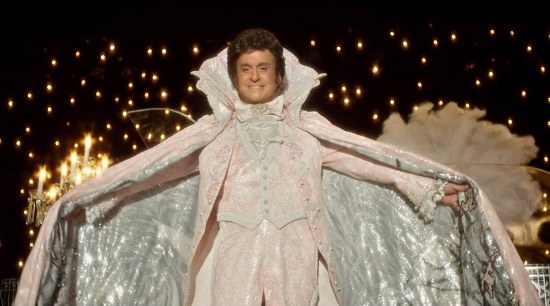"Nakedness makes us democratic, adornment makes us individuals." – Liberace. A reversal of the above quotation forms the dualism at the heart of Soderbergh’s simultaneously scintillating and stifling portrayal of the public/private divide that surrounded the famous pianist (captured expertly by Michael Douglas) and his volatile relationship with former veterinarian Scott Thorson (Matt Damon).
Soderbergh fashions the film into a diptych of sorts, with two, somewhat antithetical, thematic blocks. Through the eyes of Damon’s Scott, happening upon a performance by the pianist, we are initially introduced to Liberace’s publicly projected and meticulously constructed persona. His striving for individuation is stitched together through an elaborate mesh of sartorial and performative ‘adornments’. His famously peacockish outfits work alongside his effortlessly engaging audience participation methods and a wisecracking sleight of hand, to introduce a campness (unreadable for Liberace’s largely senior female audience at the time) and a camping of professional protocols associated with traditionally straight-laced classical musical performance.
Soderbergh’s employment of heavy colour correction in these opening segments lends the images a sickly sweet dazzle. This simultaneously emphasises the mesmeric persona Liberace built for his outward projection, but also quite crucially, the falsity of the same. After the show Scott is introduced to Liberace, watched under the scornful eye of the pianist’s current “protégé” Billy Leatherwood (played almost mutely by Cheyenne Jackson). Throughout Soderbergh’s oeuvre he has developed a penchant for static lingering shots and visual/aural disjuncture within conversation sequences. These have quite brilliantly exacerbated moments of emotional/sexual desire between characters. Here they succeed in portraying the early lustful yearnings between Scott and Liberace. Within Soderbergh’s compact and lean directorial style, gazes function less as sub-textural accents but actually serve to create emotional weight in their own right.
Thoughout this rapturous opening hour we see Scott slowly assimilated into Liberace’s daily life – becoming a part of his stage performance as a caricature chauffeur, while also melding into his private sphere of champagne and (many, many) bubble baths. Soderbergh keeps everything aesthetically ramped up to eleven for such a lengthy time that we almost come to expect a fall, a collapse in this idyll. And come it does.
It is a shocking ‘mirror stage’-esque confrontation for Liberace which shifts the film into a continuous downward spiral in its latter half, rupturing abruptly the pair’s ‘honeymoon period’. Upon witnessing a television spot featuring the pianist (meticulously video recorded by the pair) Liberace is confronted with his own aging appearance. Surgery, he feels, is the answer. What follows is the employment of a now staple (and oddly specific) Soderberghian device: abrupt surgical sequences filmed in an unflinchingly detailed and sterile fashion- fixed camera close ups and brilliant prosthetic work become strangely affecting here.
In Soderbergh’s 2011 medical thriller Contagion, such scenes functioned to indicate the disposability of the director’s star cast. Here they act to undermine the confidence we have initially instilled in Douglas’s character. Up until this moment we are given a sense that, despite his highly stylised and constructed persona, Liberace has a decent moral code and integrity of purpose lurking behind his synthetic exterior. The visceral nature of these surgical sequences however soon begins to undermine our faith in Liberace, as well as his guiding influence over Scott. Stripped back and wigless, we see Liberace exposed. Without his individuating adornments he is hopelessly human and vulnerable.
The recovery phase for the pair means virtual lockdown in Liberace’s mansion. This location initially managed to exude a dazzling aura of sexual and societal revolution, but now it seems that the palace has become a prison. Within the first half of the film Soderbergh favoured shooting in fairly tight close ups, building the pair’s blossoming relationship through facial gestures and subtle movements, all bathed in a glowing golden light. Within the film’s second half, however, Soderbergh pulls back from the characters, utilising wide-angle lenses and a greater depth of field- playing up the oppressive quality the grand home holds. Objects and trinkets seeming now to weigh in on them.
As Soberbergh himself suggests, wide angles “create a different kind of interaction among the actors and a more expressive sense of the fictional space they inhabit.” Through these wider angles and protracted shots Soderbergh is able to leave in conversational longueurs, subtly indicating the decline of the pair’s relationship.
With Behind the Candelabra Soderbergh has crafted a work of real emotional weight, by way of a rigid adherence to his tried and tested aesthetic techniques. Towards the film’s climax, colours drain out, the cameras draw back, the shots lengthen, then its over- a fitting end to both Liberace and the director’s careers.


